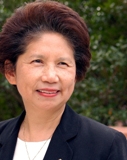
Back in May 2009,when Dr.Alice Yu presented the results of the Phase III clinical trial of a noval antibody-based immunotherapy (chimeric anti-GD2 antibody ch14.18) for treating high-risk Neuroblastoma patients at the annual meeting of the American Society of Clinical Oncology (ASCO), it was listed as top 5 targeted therapy and received wide attention (See Prior Report). The ch14.18 antibody immunotherapy is now made available to all eligible patients.
Dr.Yu had then published the research of her twenty plus years struggle in getting the cure for Neuroblastoma patients on the September 30th issue of The New England Journal of Medicine, and again, a whopping number of media coverage followed. To quote from the comment made by Dr. Maris, one of the participating doctor of the clinical trial, on USA Today, “this type of immunotherapy is the holy grail of cancer therapy.” It is said so, because the ch14.18 antibody performs an accurate aim at the GD2 glycan molecules found on neuroblastoma cells and function, yet, it does almost nothing to other normal cells.
Neuroblastoma is a rare cancer found on infants. It is categorized as orphan disease, because the obvious low ROI makes it hard to attract pharmaceutical companies to adopt.
Yu had finished the MD education and training in Taiwan, and later received a Ph.D. degree in Immunology, and obtained license to practice as a research pediatrician in UCSD. It made natural for her to work in between hospital beds and lab benches, and she did so by bringing basic research knowledge into the hospital, and taking first hand patient data back to the lab for further investigation. It has been a long and lonely journey, especially when facing the academic world where publications outweigh others.
Then, together with Dr. Ralph Reisfeld from Scripps, they have identified the fact that GD2 glycan has a high expression on neuroblastoma cells, and pertained good potential as a target for treatment. Later, they designed and made the humanized antibody, the ch14.18.
Yu’s role of ch14.18 evolved from applying the IND (Investigational New Drug), and then phase I, II, and III trials, in every step of the way.
Throughout the time, the patent has been sold and resold, and at the most critical point, the trial was halted by the patent’s new owner. It was the persistence of Dr. Yu and the backup from physicians of Children’s Oncology Group, that made a turning point possible.
In 1996, Dr. Yu flew to Washington, D.C.to seek support from the governmental source. She brought loads of convincing evidence from the prior trials, and finally, the National Cancer Institute, aka. NCI, agreed to chip in to produce the agent for the study to continue.
As they moved along, it appeared the antibody-based immunotherapy was such an innovative therapy, there were gaps in between science and regulations. Luckily, the concerned parties from the agencies were open minded and sat down with Yu to walk through the holes and made adequate amendments. The funding from NCI to produce enough ch14.18 for the trial to carry on was another blessing.
Dr. Alice Yu is now a distinguished research fellow in Genomics Research Center, and leads the Medical Biology Division to study more drug development related research relating to various cancers as well as avian flu.
According to Yu, GD2 is a substance that exists on several other types of cancer cells, for example, Melanoma, Small Cell Lung Cancer, and Osteosarcoma. Therefore, this antibody strategy has presented a potential solution to these other cancer treatments, especially when nearly 80 percent of cell surface molecules contain glycans.
As far as passing her valuable experiences in translational medicine to the locals, Yu expresses confidences and hopes. She has been working on this ever since she came back to Taiwan six years ago, and her involvement in establishing a good environment for translational medicine research has only got deeper and wider. Although there are a lot to do in connecting the dots among academics, government agencies, hospitals and industries, she expressed optimistic attitude and foresees to help more people in the near future.
References:
1.Publication:
” Anti-GD2 Antibody with GM-CSF, Interleukin-2, and Isotretinoin for Neuroblastoma ”
2.NCI website:
” Turning the Immune System against a Childhood Cancer ”
3.Other media reports:
USA Today “ Experimental drug helps kids with neuroblastoma ”
CBS: “ New Treatment for Most Common Cancer in Babies ”
Nbglobe (a non-profit blog dedicated to Neuroblastoma News) “Biggest news for Neuroblastoma in a decade”